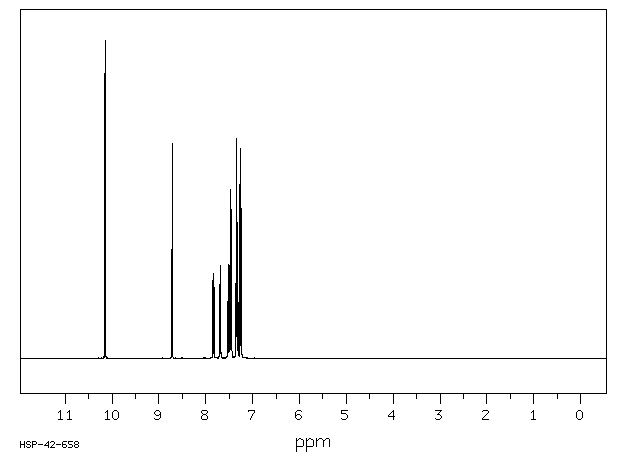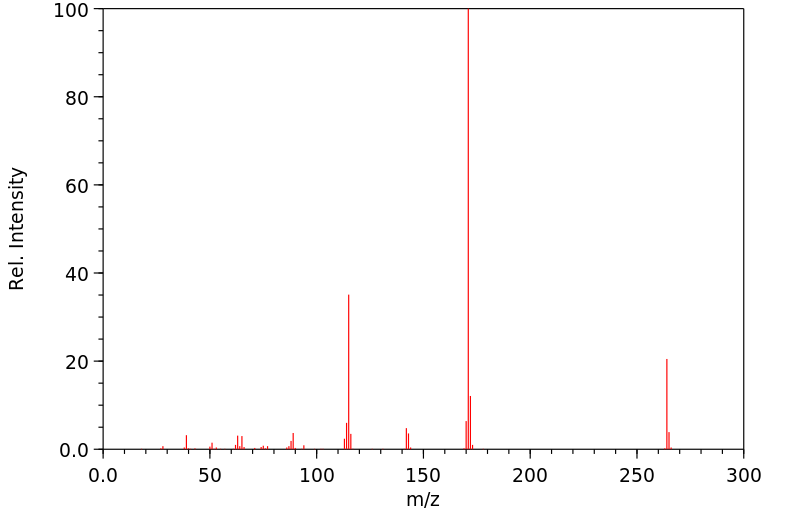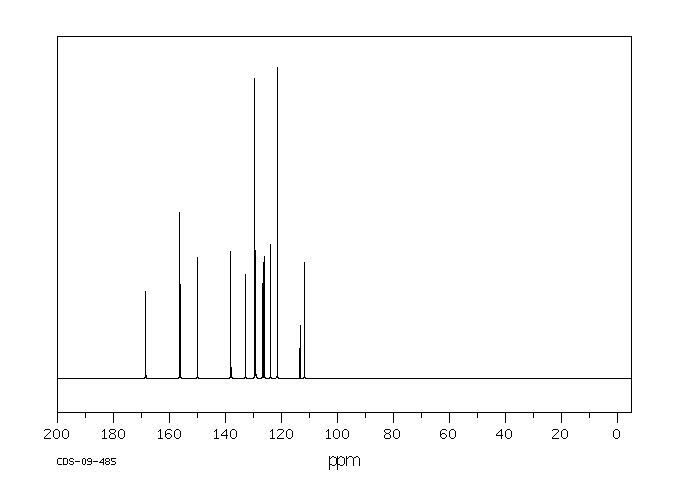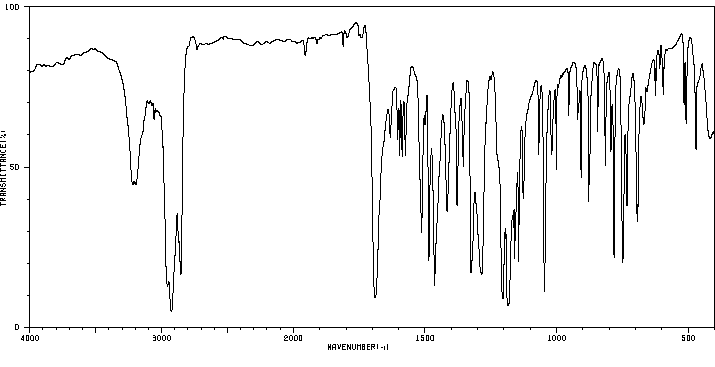3-羟基-2-萘甲酸苯酯 | 7260-11-9
中文名称
3-羟基-2-萘甲酸苯酯
中文别名
——
英文名称
phenyl 3-hydroxy-2-naphthoate
英文别名
phenyl 2-hydroxy-3-naphthoate;phenyl 3-hydroxynaphthalene-2-carboxylate
CAS
7260-11-9
化学式
C17H12O3
mdl
MFCD00004098
分子量
264.28
InChiKey
SRMZHGJLSDITLO-UHFFFAOYSA-N
BEILSTEIN
——
EINECS
——
-
物化性质
-
计算性质
-
ADMET
-
安全信息
-
SDS
-
制备方法与用途
-
上下游信息
-
文献信息
-
表征谱图
-
同类化合物
-
相关功能分类
-
相关结构分类
物化性质
-
熔点:129-132 °C (lit.)
-
沸点:257-261 °C/160 mmHg (lit.)
-
密度:1.1852 (rough estimate)
-
稳定性/保质期:
在常温常压下保持稳定,应避免与不相容的材料及强氧化剂接触。与强氧化剂反应时需谨慎。
计算性质
-
辛醇/水分配系数(LogP):4.8
-
重原子数:20
-
可旋转键数:3
-
环数:3.0
-
sp3杂化的碳原子比例:0.0
-
拓扑面积:46.5
-
氢给体数:1
-
氢受体数:3
安全信息
-
危险品标志:Xi
-
安全说明:S24/25
-
危险类别码:R36/37/38
-
WGK Germany:3
-
储存条件:密封储存,应存放在阴凉、干燥的仓库中。
SDS
模块 1. 化学品
1.1 产品标识符
: 3-羟基-2-萘甲酸苯酯
产品名称
1.2 鉴别的其他方法
无数据资料
1.3 有关的确定了的物质或混合物的用途和建议不适合的用途
仅用于研发。不作为药品、家庭或其它用途。
模块 2. 危险性概述
2.1 GHS-分类
皮肤刺激 (类别 2)
眼睛刺激 (类别 2A)
特异性靶器官系统毒性(一次接触) (类别 3)
2.2 GHS 标记要素,包括预防性的陈述
象形图
警示词 警告
危险申明
H315 造成皮肤刺激。
H319 造成严重眼刺激。
H335 可能引起呼吸道刺激。
警告申明
预防
P261 避免吸入粉尘/烟/气体/烟雾/蒸气/喷雾.
P264 操作后彻底清洁皮肤。
P271 只能在室外或通风良好之处使用。
P280 穿戴防护手套/ 眼保护罩/ 面部保护罩。
响应
P302 + P352 如皮肤接触:用大量肥皂和水清洗。
P304 + P340 如吸入: 将患者移到新鲜空气处休息,并保持呼吸舒畅的姿势。
P305 + P351 + P338 如与眼睛接触,用水缓慢温和地冲洗几分钟。如戴隐形眼镜并可方便地取
出,取出隐形眼镜,然后继续冲洗.
P312 如感觉不适,呼救中毒控制中心或医生.
P321 具体治疗(见本标签上提供的急救指导)。
P332 + P313 如发生皮肤刺激:求医/ 就诊。
P337 + P313 如仍觉眼睛刺激:求医/就诊。
P362 脱掉沾染的衣服,清洗后方可重新使用。
储存
P403 + P233 存放于通风良的地方。 保持容器密闭。
P405 存放处须加锁。
处置
P501 将内容物/ 容器处理到得到批准的废物处理厂。
2.3 其它危害物 - 无
模块 3. 成分/组成信息
3.1 物 质
: C17H12O3
分子式
: 264.28 g/mol
分子量
组分 浓度或浓度范围
Phenyl 3-hydroxy-2-naphthoate
-
化学文摘登记号(CAS 7260-11-9
No.) 230-681-1
EC-编号
模块 4. 急救措施
4.1 必要的急救措施描述
一般的建议
请教医生。 向到现场的医生出示此安全技术说明书。
吸入
如果吸入,请将患者移到新鲜空气处。 如呼吸停止,进行人工呼吸。 请教医生。
皮肤接触
用肥皂和大量的水冲洗。 请教医生。
眼睛接触
用大量水彻底冲洗至少15分钟并请教医生。
食入
切勿给失去知觉者通过口喂任何东西。 用水漱口。 请教医生。
4.2 主要症状和影响,急性和迟发效应
据我们所知,此化学,物理和毒性性质尚未经完整的研究。
4.3 及时的医疗处理和所需的特殊处理的说明和指示
无数据资料
模块 5. 消防措施
5.1 灭火介质
灭火方法及灭火剂
用水雾,抗乙醇泡沫,干粉或二氧化碳灭火。
5.2 源于此物质或混合物的特别的危害
碳氧化物
5.3 给消防员的建议
如必要的话,戴自给式呼吸器去救火。
5.4 进一步信息
无数据资料
模块 6. 泄露应急处理
6.1 作业人员防护措施、防护装备和应急处置程序
使用个人防护用品。 避免粉尘生成。 避免吸入蒸气、烟雾或气体。 保证充分的通风。
人员疏散到安全区域。 避免吸入粉尘。
6.2 环境保护措施
不要让产品进入下水道。
6.3 泄漏化学品的收容、清除方法及所使用的处置材料
收集和处置时不要产生粉尘。 扫掉和铲掉。 放入合适的封闭的容器中待处理。
6.4 参考其他部分
丢弃处理请参阅第13节。
模块 7. 操作处置与储存
7.1 安全操作的注意事项
避免接触皮肤和眼睛。 避免形成粉尘和气溶胶。
在有粉尘生成的地方,提供合适的排风设备。一般性的防火保护措施。
7.2 安全储存的条件,包括任何不兼容性
贮存在阴凉处。 使容器保持密闭,储存在干燥通风处。
7.3 特定用途
无数据资料
模块 8. 接触控制和个体防护
8.1 容许浓度
最高容许浓度
没有已知的国家规定的暴露极限。
8.2 暴露控制
适当的技术控制
根据良好的工业卫生和安全规范进行操作。 休息前和工作结束时洗手。
个体防护设备
眼/面保护
带有防护边罩的安全眼镜符合 EN166要求请使用经官方标准如NIOSH (美国) 或 EN 166(欧盟)
检测与批准的设备防护眼部。
皮肤保护
戴手套取 手套在使用前必须受检查。
请使用合适的方法脱除手套(不要接触手套外部表面),避免任何皮肤部位接触此产品.
使用后请将被污染过的手套根据相关法律法规和有效的实验室规章程序谨慎处理. 请清洗并吹干双手
所选择的保护手套必须符合EU的89/686/EEC规定和从它衍生出来的EN 376标准。
身体保护
防渗透的衣服, 防护设备的类型必须根据特定工作场所中的危险物的浓度和数量来选择。
呼吸系统防护
如须暴露于有害环境中,请使用P95型(美国)或P1型(欧盟 英国
143)防微粒呼吸器。如需更高级别防护,请使用OV/AG/P99型(美国)或ABEK-P2型 (欧盟 英国 143)
防毒罐。
呼吸器使用经过测试并通过政府标准如NIOSH(US)或CEN(EU)的呼吸器和零件。
模块 9. 理化特性
9.1 基本的理化特性的信息
a) 外观与性状
形状: 固体
b) 气味
无数据资料
c) 气味阈值
无数据资料
d) pH值
无数据资料
e) 熔点/凝固点
熔点/凝固点: 129 - 132 °C - lit.
f) 沸点、初沸点和沸程
257 - 261 °C 在 213 hPa - lit.
g) 闪点
无数据资料
h) 蒸发速率
无数据资料
i) 易燃性(固体,气体)
无数据资料
j) 高的/低的燃烧性或爆炸性限度 无数据资料
k) 蒸气压
无数据资料
l) 蒸汽密度
无数据资料
m) 密度/相对密度
无数据资料
n) 水溶性
无数据资料
o) n-辛醇/水分配系数
无数据资料
p) 自燃温度
无数据资料
q) 分解温度
无数据资料
r) 粘度
无数据资料
模块 10. 稳定性和反应活性
10.1 反应性
无数据资料
10.2 稳定性
无数据资料
10.3 危险反应
无数据资料
10.4 应避免的条件
无数据资料
10.5 不相容的物质
强氧化剂
10.6 危险的分解产物
其它分解产物 - 无数据资料
模块 11. 毒理学资料
11.1 毒理学影响的信息
急性毒性
无数据资料
皮肤刺激或腐蚀
无数据资料
眼睛刺激或腐蚀
无数据资料
呼吸道或皮肤过敏
无数据资料
生殖细胞突变性
无数据资料
致癌性
IARC:
此产品中没有大于或等于 0。1%含量的组分被 IARC鉴别为可能的或肯定的人类致癌物。
生殖毒性
无数据资料
特异性靶器官系统毒性(一次接触)
吸入 - 可能引起呼吸道刺激。
特异性靶器官系统毒性(反复接触)
无数据资料
吸入危险
无数据资料
潜在的健康影响
吸入 吸入可能有害。 引起呼吸道刺激。
摄入 如服入是有害的。
皮肤 通过皮肤吸收可能有害。 造成皮肤刺激。
眼睛 造成严重眼刺激。
接触后的征兆和症状
据我们所知,此化学,物理和毒性性质尚未经完整的研究。
附加说明
化学物质毒性作用登记: 无数据资料
模块 12. 生态学资料
12.1 生态毒性
无数据资料
12.2 持久性和降解性
无数据资料
12.3 潜在的生物累积性
无数据资料
12.4 土壤中的迁移性
无数据资料
12.5 PBT 和 vPvB的结果评价
无数据资料
12.6 其它不良影响
无数据资料
模块 13. 废弃处置
13.1 废物处理方法
产品
将剩余的和不可回收的溶液交给有许可证的公司处理。
联系专业的拥有废弃物处理执照的机构来处理此物质。
与易燃溶剂相溶或者相混合,在备有燃烧后处理和洗刷作用的化学焚化炉中燃烧
受污染的容器和包装
按未用产品处置。
模块 14. 运输信息
14.1 联合国危险货物编号
欧洲陆运危规: - 国际海运危规: - 国际空运危规: -
14.2 联合国运输名称
欧洲陆运危规: 非危险货物
国际海运危规: 非危险货物
国际空运危规: 非危险货物
14.3 运输危险类别
欧洲陆运危规: - 国际海运危规: - 国际空运危规: -
14.4 包裹组
欧洲陆运危规: - 国际海运危规: - 国际空运危规: -
14.5 环境危险
欧洲陆运危规: 否 国际海运危规 国际空运危规: 否
海洋污染物(是/否): 否
14.6 对使用者的特别提醒
无数据资料
模块 15 - 法规信息
N/A
模块16 - 其他信息
N/A
上下游信息
-
上游原料
中文名称 英文名称 CAS号 化学式 分子量 2-羟基-3-萘甲酸 3-Hydroxy-2-naphthoic acid 92-70-6 C11H8O3 188.183 -
下游产品
中文名称 英文名称 CAS号 化学式 分子量 —— diphenyl 2,2'-dihydroxy-[1,1'-binaphthalene]-3,3'-dicarboxylate 170889-47-1 C34H22O6 526.545
反应信息
-
作为反应物:描述:3-羟基-2-萘甲酸苯酯 在 氧气 作用下, 以 甲苯 为溶剂, 反应 12.0h, 以75%的产率得到diphenyl 2,2'-dihydroxy-[1,1'-binaphthalene]-3,3'-dicarboxylate参考文献:名称:在可见光照射下使用杂化还原氧化石墨烯/二氧化锰纳米复合材料对2-萘酚进行光化学氧化偶联摘要:我们描述了一种简单的,具有成本效益,高效且高产的光催化方法,该方法使用由金属-金属杂化物组成的2-萘酚的氧化自二聚,该杂化物由在还原的氧化石墨烯(rGO / MnO 2)中嵌入的二氧化锰纳米颗粒组成。在可见光照射下。通过将MnO 2纳米粒子与rGO超声混合,一步即可合成所需的光催化剂。杂化光催化剂显示出比纯MnO 2纳米颗粒和rGO显着更高的活性,这被认为是由于其组分的协同作用。据我们所知,这种混合rGO / MnO 2 纳米复合材料是第一种在温和条件下氧化2-萘酚的多相绿色光催化剂。DOI:10.1002/cctc.201701470
-
作为产物:描述:参考文献:名称:酚醛酯与烷基溴化物的镍催化定向交叉亲电偶联摘要:在本文中,我们证明了在各种伯和仲未活化烷基溴的反应中,成功使用了强健的酚酯作为亲电子酰基源。相邻的羟基或磺酰胺部分可促进相对惰性的C-O键的裂解。通过避免使用预生成的有机金属,该方法可以有效地制备具有高相容性和广泛功能的各种邻羟基和甲苯磺酰基保护的邻氨基芳基酮。DOI:10.1021/acs.orglett.0c03342
文献信息
-
Preparation of Novel Polycyclic Heterocycles Using a Tin(II) Chloride Dihydrate-Mediated Deacetalisation-Bicyclisation Sequence作者:Richard Taylor、Alex Cayley、Katherine Gallagher、Cécilia Ménard-Moyon、Jan Schmidt、Louis DiorazioDOI:10.1055/s-0028-1083214日期:2008.12Tin(II) chloride dihydrate-mediated deacetalisation- bicyclisation procedures for the construction of novel polycyclic heterocycles from amides possessing a pendant acetal group are re- ported. Optimisation and scoping studies are described; using this methodology, a range of known, and novel, ring-fused heterocyclic systems have been prepared, some in enantiomerically pure form.
-
Copper‐Complex‐Catalyzed Asymmetric Aerobic Oxidative Cross‐Coupling of 2‐Naphthols: Enantioselective Synthesis of 3,3′‐Substituted <i> C <sub>1</sub> </i> ‐Symmetric BINOLs作者:Jin‐Miao Tian、Ai‐Fang Wang、Ju‐Song Yang、Xiao‐Jing Zhao、Yong‐Qiang Tu、Shu‐Yu Zhang、Zhi‐Min ChenDOI:10.1002/anie.201903435日期:2019.8.5A novel chiral 1,5‐N,N‐bidentate ligand based on a spirocyclic pyrrolidine oxazoline backbone was designed and prepared, and it coordinates CuBr in situ to form an unprecedented catalyst that enables efficient oxidative cross‐coupling of 2‐naphthols. Air serves as an external oxidant and generates a series of C1‐symmetric chiral BINOL derivatives with high enantioselectivity (up to 99 % ee) and good
-
Synthesis of Diazonaphthoquinones from Naphthols by Diazo-Transfer Reaction作者:Mitsuru Kitamura、Rie Sakata、Norifumi Tashiro、Azusa Ikegami、Tatsuo OkauchiDOI:10.1246/bcsj.20150021日期:2015.6.15Various orthodiazonaphthoquinones (1-diazo-2(1H)-naphthalenones and 2-diazo-1(2H)-naphthalenones) were synthesized using the diazo-transfer reaction between the appropriate naphthol and 2-azido-1,3-dimethylimidazolinium chloride (ADMC). The ADMC was prepared by the reaction between 2-chloro-1,3-dimethylimidazolinium chloride and sodium azide. The diazo-transfer reaction selectively introduced the diazo group at the C(2) position of 1-naphthol or the C(1) position of 2-naphthol. The naphthalenediols that were tested, except for 1,3-naphthalenediol, also reacted with ADMC to afford the corresponding monodiazotized compound. X-ray analyses suggested that the diazonaphthoquinones did not have diazoniumnaphtholate structures but had diazocarbonyl structures.
-
Cu(I)-catalyzed asymmetric oxidative cross-coupling of 2-naphthol derivatives作者:Tomohisa Temma、Bunpei Hatano、Shigeki HabaueDOI:10.1016/j.tet.2006.06.069日期:2006.9asymmetric oxidative coupling reaction between 2-naphthol or binaphthol derivatives and 3-hydroxy-2-naphthoate derivatives with the copper(I)-(S)-(−)-isopropylidenebis(4-phenyl-2-oxazoline) catalyst was carried out. The reaction proceeded in a highly cross-coupling selective manner (≤99.7%) to produce the binaphthyl or quaternaphthyl derivative in good yield (≤92%) with enantioselectivity of up to 74%
-
Heterocyclische Spirocyclohexadienone, 3. Mitt.作者:Hans Möhrle、Dieter SchakeDOI:10.1002/ardp.19953280602日期:——3‐Substituierte 2‐Naphtholderivate ergeben mit N‐Methyl‐2‐naphthylamin und Paraformaldehyd in guten Ausb. entspr. Spirocyclohexadienone, wobei auch 9‐Phenanthrol diesem Reaktionstyp zugänglich ist. Grundsätzlich liefern 4‐substituierte 1‐Naphthole ebenfalls Spiroketone, die jedoch labiler sind und in geringerem Ausmaß anfallen. Die Umsetzung der Spirocyclohexadienone mit Protonensäuren, Carbonylreagenzien
表征谱图
-
氢谱1HNMR
-
质谱MS
-
碳谱13CNMR
-
红外IR
-
拉曼Raman
-
峰位数据
-
峰位匹配
-
表征信息
同类化合物
(S)-溴烯醇内酯
(R)-3,3''-双([[1,1''-联苯]-4-基)-[1,1''-联萘]-2,2''-二醇
(3S,3aR)-2-(3-氯-4-氰基苯基)-3-环戊基-3,3a,4,5-四氢-2H-苯并[g]吲唑-7-羧酸
(3R,3’’R,4S,4’’S,11bS,11’’bS)-(+)-4,4’’-二叔丁基-4,4’’,5,5’’-四氢-3,3’’-联-3H-二萘酚[2,1-c:1’’,2’’-e]膦(S)-BINAPINE
(11bS)-2,6-双(3,5-二甲基苯基)-4-羟基-4-氧化物-萘并[2,1-d:1'',2''-f][1,3,2]二氧磷
(11bS)-2,6-双(3,5-二氯苯基)-4羟基-4-氧-二萘并[2,1-d:1'',2''-f][1,3,2]二氧磷杂七环
(11bR)-2,6-双[3,5-双(1,1-二甲基乙基)苯基]-4-羟基-4-氧化物-二萘并[2,1-d:1'',2''-f][1,3,2]二氧杂磷平
黄胺酸
马兜铃对酮
马休黄钠盐一水合物
马休黄
食品黄6号
食品红40铝盐色淀
飞龙掌血香豆醌
颜料黄101
颜料红70
颜料红63
颜料红53:3
颜料红5
颜料红48单钠盐
颜料红48:2
颜料红4
颜料红261
颜料红258
颜料红220
颜料红22
颜料红214
颜料红2
颜料红19
颜料红185
颜料红184
颜料红170
颜料红148
颜料红147
颜料红146
颜料红119
颜料红114
颜料红 9
颜料红 21
颜料橙7
颜料橙46
颜料橙38
颜料橙3
颜料橙22
颜料橙2
颜料橙17
颜料橙 5
颜料棕1
顺式-阿托伐醌-d5
雄甾烷-3,17-二酮










